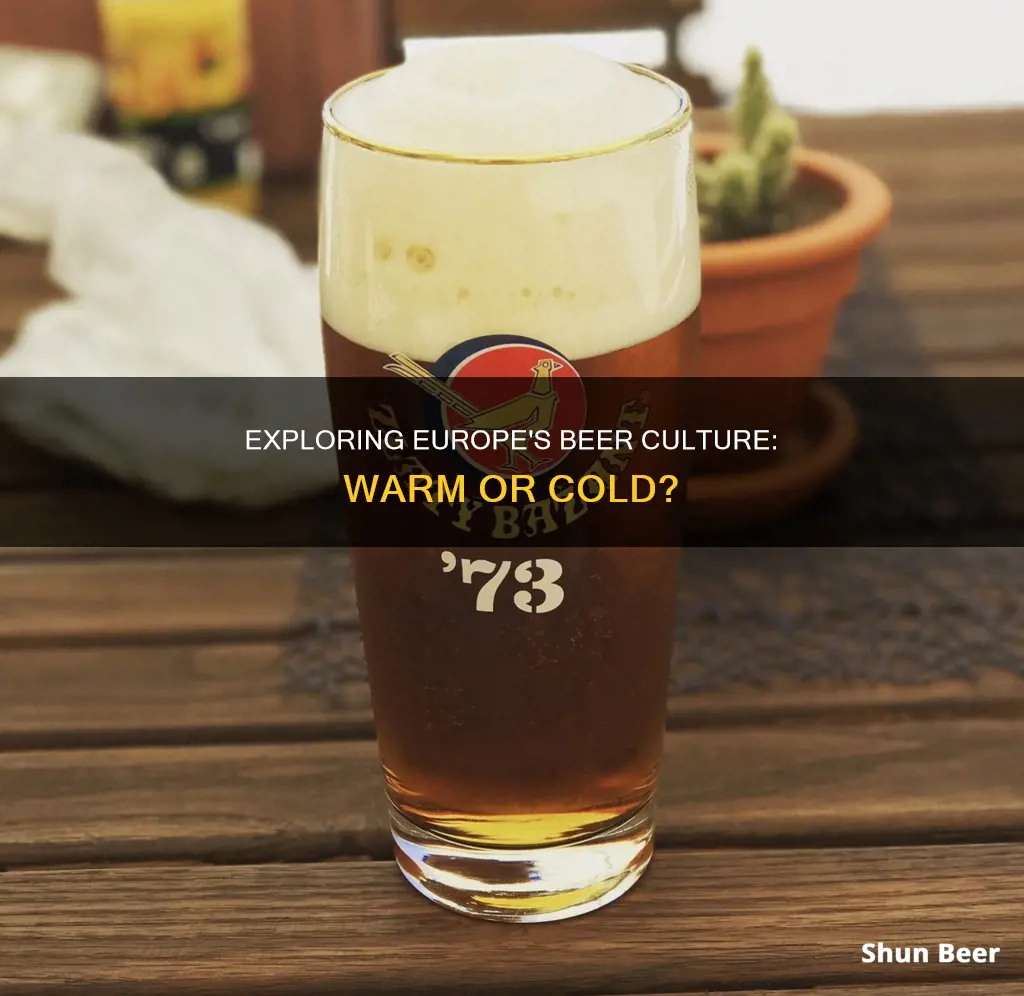
The idea that Europeans drink warm beer is a common misconception. While it is true that Europeans tend to prefer their beer at a slightly higher temperature than Americans, it is not accurate to say that they drink it warm. In fact, Europeans typically enjoy their beer at cellar temperature, which is slightly colder than room temperature. This preference for warmer beer may have originated during the Second World War when American soldiers stationed in Europe encountered local drinking cultures for the first time. Europeans argue that drinking beer at a slightly higher temperature enhances its flavour and richness.
| Characteristics | Values |
|---|---|
| Origin of the myth | Likely during the Second World War when American soldiers in Britain were served cask beer, which was not as cold as they were used to. |
| Beer temperature preferences | Europeans prefer beer at cellar temperature, which is slightly colder than room temperature. |
| Purpose of drinking warm beer | Drinking beer at room temperature allows the richness and complexity of the beer to come to the fore. |
| Beer temperature in Europe | Ale is recommended to be served at 50-55°F, while lager is served at a slightly colder temperature. |
| Ice usage | In Europe, ice is not commonly used, and people usually have to ask for it specifically. |
What You'll Learn

Europeans prefer beer at cellar temperature
In reality, the serving temperature for beer in Europe depends on the style of beer. Ale is typically served at a warmer temperature than lager, with an ale's recommended serving temperature being between 50 and 55 degrees Fahrenheit, and lager served between 45 and 50 degrees Fahrenheit. These temperatures allow the richness and complexity of the beer to come through and are considered "cool and refreshing" by European standards.
In Central Europe, it was once common to use a "bierwärmer" or "ohříváček" in Czech, to heat beer to the optimal temperature. This device is a narrow metal tube with a hanger that is filled with hot water and dipped into the beer. However, the use of beer warmers has declined in recent years, and they are now a rare sight even in Central Europe.
While Europeans may enjoy an ice-cold beer on a hot summer day, they generally believe that drinking beer at a slightly warmer temperature enhances the flavour and aroma of the beverage. This is in line with the European view that beer is a drink to be savoured and appreciated, rather than simply consumed for refreshment.
Additionally, in Europe, it is typical for all drinks, including soda, water, and juice, to be served without ice unless specifically requested. This cultural preference for drinks at cellar or room temperature may also contribute to the misconception that Europeans drink warm beer.
Enjoying Beer After LASIK: What You Need to Know
You may want to see also

The myth of Europeans drinking warm beer
It is a common misconception that Europeans drink warm beer. This myth likely originated during World War II when American soldiers stationed in Britain were surprised to find that the local beer was not served ice-cold like they were accustomed to back home. Instead, the British drank cask beer, which is typically served at cellar temperature, a little colder than room temperature.
The idea that Europeans drink warm beer is a gross exaggeration. In reality, Europeans simply prefer their beer less chilled than Americans. In Europe, beer is generally considered to be optimally refreshing when served at around 45-55°F (7-13°C). This temperature is believed to bring out the richness and complexity of the beer's flavour and aroma. Serving beer ice-cold, on the other hand, is thought to be a way to disguise the lack of flavour in low-quality brews.
In Central Europe, it was once common to use a "bierwärmer" or "ohříváček" in Czech—a narrow metal tube filled with hot water and hung in the glass to bring the beer to the desired temperature. However, even in this region, beer is now typically served colder than it was a century ago, and the use of beer warmers has declined significantly.
While it is true that Europeans may drink their beer at a slightly warmer temperature than Americans, it is inaccurate to say that they drink warm beer. The myth likely persists due to differing cultural attitudes towards beer. In Europe, beer is often consumed as a casual beverage, similar to soda or water, and is not always associated with a "refreshing" quality.
Testosterone and Beer: Is It Safe to Drink Alcohol?
You may want to see also

Central Europeans heat their beer with a Bierwärmer
Despite the popular belief that Europeans drink warm beer, this is actually a myth that is believed to have first taken root during World War II. While it is true that Europeans, and especially Central Europeans, drink beer at a warmer temperature than Americans, it is not warm. In fact, Central Europeans have long relied on a discreet device to bring their beers to the optimal temperature: a beer warmer, or Bierwärmer in German.
A Bierwärmer is a narrow metal tube with a hanger that is filled with hot water, closed with a lid, and then hung in a glass of beer. The consumer can then adjust the temperature of the beer to their taste. This device is particularly useful in the dead of winter in Central Europe, where an ice-cold beer is sometimes too cold.
While the use of Bierwärmers has declined in recent years, they were once a common sight in Czech pubs, often given as Christmas presents for fathers and grandfathers. Today, they are a rare sight even in the homeland of lager brewing and are almost completely unknown outside of it. However, there has been a recent resurgence of interest in this obscure device, with conversations on Reddit forums, Twitter, and elsewhere sparking curiosity among beer and history enthusiasts.
In addition to using Bierwärmers, Central Europeans have other methods for achieving the optimal beer temperature. For example, they may ask for a bottle from the crate in the cellar instead of the refrigerator or request a glass that has been rinsed in hot water. Ultimately, while Central Europeans may heat their beer, they are not drinking it warm, but rather at a temperature that allows the richness and complexity of the beer to come through.
Beer and Farxiga: What You Need to Know
You may want to see also

Brits like their beer cool, not warm
However, the reality is quite different. Cask beer, or real ale, is not supposed to be served warm or even tepid. Its recommended serving temperature is between 10-13°C (and slightly higher for stouts), which is cool and refreshing and allows the richness and complexity of the beer to come through. This temperature is not room temperature but rather cellar temperature, where beer is traditionally stored and can stay cool without refrigeration.
While some Brits do enjoy a cool, refreshing ale, others prefer their beer cold. Lager, in particular, is served colder than ale, typically between 7-10°C, to enhance the hop aromas and delicate flavours. The preference for extra cold beer has been influenced by large brewers who promote the idea of extra refreshment while also masking the lack of flavour in their beers.
In Central Europe, the optimal drinking temperature for beer is also slightly warmer than what might be considered ice-cold. In the past, beer warmers were used to bring beer to the ideal temperature, especially during the colder months. While beer warmers are now rare, some Central Europeans still ask for their beers to be warmed up, especially if they are unwell or prefer the more traditional serving temperatures.
So, while Brits may have a reputation for drinking warm beer, the reality is that they, like many other Europeans, prefer their beer cool or cold, depending on the style and their personal taste.
Beer Beyond Best Before: Is It Safe to Drink?
You may want to see also

Europeans believe ice-cold beer defeats the purpose
Europeans do not drink warm beer, but they also don't drink ice-cold beer. They believe that ice-cold beer defeats the purpose of drinking beer, as the extreme cold can mask the flavours and aromas of the beverage. Europeans prefer their beer at cellar temperature, which is slightly colder than room temperature. This allows the richness and flavour of the beer to come forward.
The myth that Europeans drink warm beer likely originated during the Second World War when American soldiers in Britain were surprised to find that the local beer was not as icy cold as the beer they were used to back home. This myth has persisted and evolved into common knowledge among Americans. However, it is important to note that the "warm" beer Europeans drink is not actually warm, but rather served at a temperature that allows for an optimal drinking experience, highlighting the nuances of the beverage.
The preference for drinking beer at a slightly warmer temperature is not limited to Europe. In Central Europe, for example, lager-loving regions like the Czech Republic and Germany, beer warmers were once a common sight. These devices, called "bierwärmer" in German and "ohříváček" in Czech, are narrow metal tubes with a hanger that are dipped into the beer to bring it to the desired temperature. While the use of beer warmers has declined in recent years, it is not uncommon for Central Europeans to ask for their beers to be warmed up, especially during the winter months.
The optimal temperature for serving beer depends on the style of beer and the region. For example, in Central Europe, the recommended serving temperature for pale beers is 9 to 11 degrees Celsius (about 48 to 52 degrees Fahrenheit), and for dark beer, it is 11 to 13 degrees Celsius (about 52 to 55 degrees Fahrenheit). These temperatures may vary slightly in other European countries, but the principle remains the same: Europeans believe that drinking beer ice-cold is not the best way to appreciate its flavour and aroma.
Beer Overdose: Can Drinking Beer Kill You?
You may want to see also
Frequently asked questions
No, Europeans don't drink warm beer. They prefer it at cellar temperature, which is slightly colder than room temperature. This myth likely originated during World War II when American soldiers in Britain were served cask beer, which was less chilly than they expected.
The ideal temperature for drinking beer depends on the type of beer and personal preference. Generally, lager is served colder than ale, and different types of beer have different recommended temperature ranges to bring out their unique flavours and aromas.
Europeans believe that drinking beer at room or cellar temperature allows them to enjoy all the flavours, aromas, and scents of the beverage. They argue that serving a drink at room temperature indicates its quality, and ice is not commonly used in Europe unless requested.







